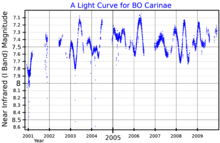BO Carinae, also known as HD 93420, is an irregular variable star in the constellation Carina.
 BO Carinae is the brightest red star, towards upper left, in this image of the Carina Nebula. Credit: ESO | |
| Observation data Epoch J2000 Equinox J2000 | |
|---|---|
| Constellation | Carina |
| Right ascension | 10h 46m 00.53s |
| Declination | 59° 29′ 19.5″ |
| Apparent magnitude (V) | 7.18 - 8.50[1] |
| Characteristics | |
| Spectral type | M4 Ib[1] |
| Variable type | Lc[1] |
| Astrometry | |
| Proper motion (μ) | RA: −7.334±0.027[2] mas/yr Dec.: −1.420±0.028[2] mas/yr |
| Parallax (π) | 0.6020 ± 0.0259 mas[2] |
| Distance | 5,400 ± 200 ly (1,660 ± 70 pc) |
| Absolute magnitude (MV) | –5.53[3] |
| Details | |
| Radius | 439[4] R☉ |
| Luminosity | 26,000 - 27,000[4] L☉ |
| Temperature | 3,535±170[4] K |
| Other designations | |
BO Car, IDS 10419-5858, IRAS 10438-5913, 2MASS J10455065-5929193, AAVSO 1042-58, SAO 238447, CD-58 3547, HD 93420 | |
| Database references | |
| SIMBAD | data |
BO Car has a maximum apparent magnitude of +7.18. Its distance and membership is uncertain, but its possible membership to the star cluster Trumpler 15 allows a distance estimate of approximately 2,500 parsecs (8,150 light-years).[5][6] The Gaia Data Release 2 parallax of 0.73±0.08 mas suggests a closer distance, but the value is considered unreliable due to excess astrometric noise.[7]
BO Car is a red supergiant of spectral type M4Ib with an effective temperature of 3,525 K, a radius of 439 solar radii. Its bolometric luminosity is 26,000 L☉.[3] Mass-loss is on the order of 0.3×10−9 solar masses per year.[6]

Billed as an irregular variable like TZ Cassiopeiae or V528 Carinae; its apparent brightness fluctuates between magnitude +7.18 and +8.50 without clear periodicity.[1][9] Some observers have found BO Car not to be variable,[10] but more extensive studies find small amplitude variations with a possible period of 145 days.[11]
Multiple star catalogues list an 11th-magnitude star as a companion to BO Car. The separation was 14.2″ in 2015, and slowly increasing.[12] The companion is a distant blue giant.[13]
See also edit
References edit
- ^ a b c d Samus, N. N.; Durlevich, O. V.; et al. (2009). "VizieR Online Data Catalog: General Catalogue of Variable Stars (Samus+ 2007-2013)". VizieR On-line Data Catalog: B/GCVS. Originally Published in: 2009yCat....102025S. 1. Bibcode:2009yCat....102025S.
- ^ a b c Brown, A. G. A.; et al. (Gaia collaboration) (2021). "Gaia Early Data Release 3: Summary of the contents and survey properties". Astronomy & Astrophysics. 649: A1. arXiv:2012.01533. Bibcode:2021A&A...649A...1G. doi:10.1051/0004-6361/202039657. S2CID 227254300. (Erratum: doi:10.1051/0004-6361/202039657e). Gaia EDR3 record for this source at VizieR.
- ^ a b Levesque, Emily M.; Massey, Philip; Olsen, K. A. G.; Plez, Bertrand; Josselin, Eric; Maeder, Andre; Meynet, Georges (August 2005). "The Effective Temperature Scale of Galactic Red Supergiants: Cool, but Not As Cool As We Thought". The Astrophysical Journal. 628 (2): 973–985. arXiv:astro-ph/0504337. Bibcode:2005ApJ...628..973L. doi:10.1086/430901. S2CID 15109583.
- ^ a b c Messineo, M.; Brown, A. G. A. (2019). "A Catalog of Known Galactic K-M Stars of Class I Candidate Red Supergiants in Gaia DR2". The Astronomical Journal. 158 (1): 20. arXiv:1905.03744. Bibcode:2019AJ....158...20M. doi:10.3847/1538-3881/ab1cbd. S2CID 148571616.
- ^ Tapia, Mauricio; Roth, Miguel; Vázquez, Rubén A.; Feinstein, Alejandro (2003). "Imaging study of NGC 3372, the Carina nebula - I. UBVRIJHK photometry of Tr 14, Tr 15, Tr 16 and Car I". Monthly Notices of the Royal Astronomical Society. 339 (1): 44–62. Bibcode:2003MNRAS.339...44T. doi:10.1046/j.1365-8711.2003.06186.x. hdl:11336/36798.
- ^ a b Josselin, E.; Blommaert, J. A. D. L.; Groenewegen, M. A. T.; Omont, A.; Li, F. L. (2000). "Observational investigation of mass loss of M supergiants". Astronomy and Astrophysics. 357: 225–232. Bibcode:2000A&A...357..225J.
- ^ Brown, A. G. A.; et al. (Gaia collaboration) (August 2018). "Gaia Data Release 2: Summary of the contents and survey properties". Astronomy & Astrophysics. 616. A1. arXiv:1804.09365. Bibcode:2018A&A...616A...1G. doi:10.1051/0004-6361/201833051. Gaia DR2 record for this source at VizieR.
- ^ "ASAS All Star Catalogue". The All Sky Automated Survey. Retrieved 8 December 2021.
- ^ Chatys, Filip W.; Bedding, Timothy R.; Murphy, Simon J.; Kiss, László L.; Dobie, Dougal; Grindlay, Jonathan E. (2019). "The period-luminosity relation of red supergiants with Gaia DR2". Monthly Notices of the Royal Astronomical Society. 487 (4): 4832. arXiv:1906.03879. Bibcode:2019MNRAS.487.4832C. doi:10.1093/mnras/stz1584. S2CID 182952598.
- ^ Percy, John R.; Sato, Hiromitsu (2009-02-01). "Long Secondary Periods in Pulsating Red Supergiant Stars". Journal of the Royal Astronomical Society of Canada. 103 (1): 11. Bibcode:2009JRASC.103...11P. ISSN 0035-872X.
- ^ Percy, J. R. (2020). "Period Analysis of All-Sky Automated Survey for Supernovae (ASAS-SN) Data on a Sample of "Irregular" Pulsating Red Giants". Journal of the American Association of Variable Star Observers (Jaavso). 48 (1): 50. Bibcode:2020JAVSO..48...50P.
- ^ Mason, Brian D.; Wycoff, Gary L.; Hartkopf, William I.; Douglass, Geoffrey G.; Worley, Charles E. (2001). "The 2001 US Naval Observatory Double Star CD-ROM. I. The Washington Double Star Catalog". The Astronomical Journal. 122 (6): 3466. Bibcode:2001AJ....122.3466M. doi:10.1086/323920.
- ^ Brown, A. G. A.; et al. (Gaia collaboration) (August 2018). "Gaia Data Release 2: Summary of the contents and survey properties". Astronomy & Astrophysics. 616. A1. arXiv:1804.09365. Bibcode:2018A&A...616A...1G. doi:10.1051/0004-6361/201833051. Gaia DR2 record for this source at VizieR.